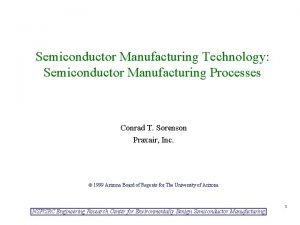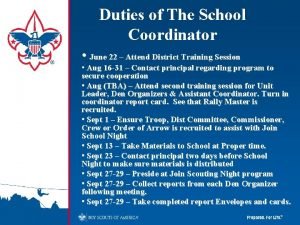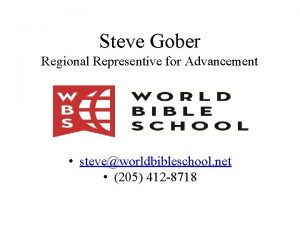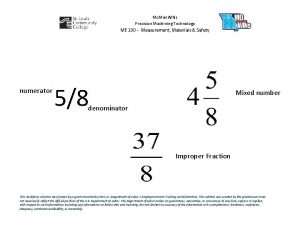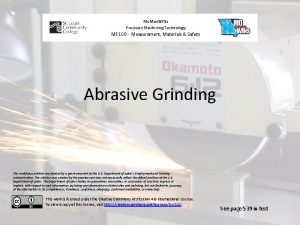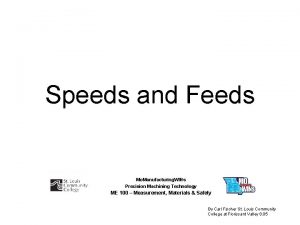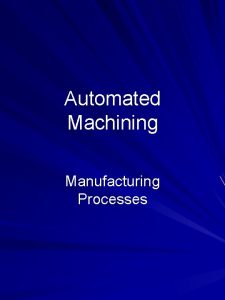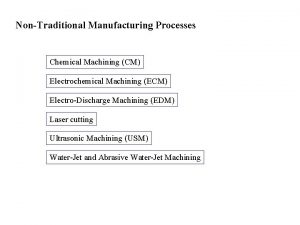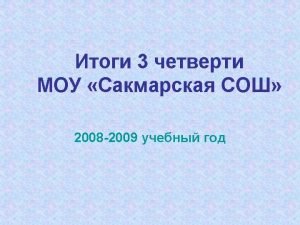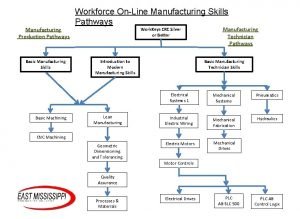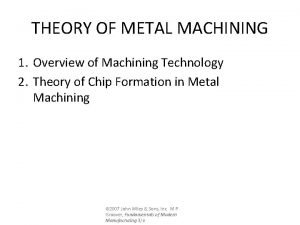Mo Manufacturing WINs Precision Machining Technology ME 100





































- Slides: 37

Mo. Manufacturing. WINs Precision Machining Technology ME 100 – Measurement, Materials & Safety What is Friction?

Different kinds of friction

Coefficient of friction The force required to drag something divided by it’s weight see page 1 -3 in the text

Bearings Two Basic Types • • • Plain Bearings or surface contact bearings. Usually made of different material than the surface they rest against. Solid Metal Powdered metal Non-metallic • • • Anti-friction or rolling element bearings Separates two surfaces with rolling elements. Ball Roller Needle

Thrust load vs. Radial load • Thrust load • Radial load

Examples of bearing types • Thrust loads Thrust Ball Bearings • Radial loads Ball bearing primarily for radial loads Roller (cylindrical) Bearing - radial Thrust roller bearing Needle bearings Similar properties as roller

Thrust and Radial loads

Linear and Recirculating Bearings

Pillow block bearings Plastic pillow blocks Pillow blocks have holes for mounting and often have holes for lubrication

Lubrication What’s a lubricant • A liquid or solid material applied between moving parts to reduce friction and minimize the heat build-up that causes wear.

Functions of a lubricant • Form a layer between moving parts thus reducing friction • To keep dirt suspended and circulating • Seal out dirt from bearing surfaces • Reduce corrosion and oxidation • Can remove some heat

Types of Lubricants • Solid – Graphite, molybdenum, lithium • Liquids – Mineral oils, vegetable oils, synthetics (esters, glycols, silicones) • Semi-liquid – Grease

Solid Lubricants Graphite Molybdenum (M 0 S 2) Lithium

Semi-Liquid (Grease) • Grease Is a lubricant containing a base lubricant of a specific viscosity, and a thickening agent that helps adhesion in different environments. • Grease Lubrication Grease is used to lubricate journal bearings when cooling of the bearing is not a factor, typically if the bearing operates at relatively low speeds. Grease is also beneficial if shock loading occurs or if the bearing frequently starts and stops or reverses direction. Grease is almost always used to lubricate pins and bushings because it provides a thicker lubricant than oil to support static loads and to protect against vibration and shockloading that are common in many of these applications. • Lithium soap or lithium complex thickeners are the most common thickeners used in greases and are excellent for most journal bearing applications. The grade of grease used is typically an NLGI grade #2 with a base oil viscosity of approximately 150 to 220 c. St at 40°C. Bearings lubricated by a centralized grease dispensing systems typically use a #1, 0 or 00 grade of grease.

Liquid Lubricants • Mineral oil – Is a bi-product of the distillation process used to make gasoline. Oil is a generic term for organic liquids that are not miscible with water. The name comes from Latin oleum (olive oil). • Synthetics - A synthetic oil is an oil manufactured for enhanced lubrication performance. This process was developed and used extensively in WWII by Germany, which had limited access to crude oil supplies. Germany's yearly synthetic oil production reached more than 90 million tons in 1944. It is today used in South Africa to produce most of that country's diesel from coal • Vegetable oil or vegoil is fat extracted from plant sources, known as oil plants. Although in principle other parts of plants may yield oil, in practice seeds form the almost exclusive source.

Lubricating systems

Oil Properties • Viscosity - the measure of the oil’s resistance to flow (shear stress) under certain conditions. To simplify, the oil’s viscosity represents the measure for which the oil wants to stay put when pushed (sheared) by moving mechanical components. • Lubricity - ability of an oil or grease to lubricate; also called film strength. • Film strength - property of a lubricant that acts to prevent scuffing or scoring of metal parts. • Drop Point – The temperature at which the grease falls away from the bearing surface

More about viscosity • • • So, viscosity is a measure of the fluid’s resistance to flow. Water has a low viscosity of 1 c. St and honey has a very high viscosity, lets say 1, 000 c. St. If a machine is heavily loaded then the machine designer will use a lubricant that resists being pushed around, which would be heavy like honey. If the machine runs very fast then the machine designer will specify a lubricant that can get out of the way, and back into the way just as quickly. Viscosities are defined or assigned using a laboratory device called a viscometer. For lubricating oils, viscometers tend to operate by gravity rather than pressure. Think of a kinematic viscometer as a long glass tube that holds a volume of oil. The measure of the fluid’s viscosity is the measure of the amount of time that it takes for the designated amount of oil to flow through the tube under very specific conditions. Water goes through in one second. The same amount of honey takes a thousand seconds (hypothetically). Another way of looking at multi-vis oils is to think of a 20 W-50 as a 20 weight oil that will not thin more than a 50 weight would when hot.

Why worry about using the correct viscosity lubricant? • If an oil viscosity is too thin for the operating temperature the protective barrier can breakdown causing metal to metal wear. Thin liquids are more likely to leak. • If an oil viscosity is too thick the lubricant wont be able to flow where it’s needed. Thick oil can cause excessive drag and overheating.

Who sets standards for lubricants? • ASTM – American Society for Testing and Materials • ISO – International Organization for Standardization • SAE – Society of Automotive Engineers


Lubricants must be selected that will work in the operating environment • • Food Industry Cold Hot Acidic • What else ?

Food Grade Lubricants • Food-grade lubricants are harmless if accidentally consumed in quantities below the maximum U. S. Food and Drug Administration (FDA)-prescribed level of 10 parts per million (ppm). The FDA has set a zero tolerance for contamination by nonfood-grade lubricants. It also regulates the components that are allowed to make up a food -grade lubricant. • How can lubricants make their way into food during the manufacturing process? Sadly, all too easily. Oil droplets can fling off machinery in fast-moving applications or grease can drip from bearings or conveyors. Critical Control Points – can seamers, bakery ovens, conveyors and the like – are of particular concern. Also, contamination can occur at any point through simple human error or equipment failure, such as hydraulic hose failure.

Bottom Line • The type of lubricant that is best suited for a particular application has been determined by the designer of the equipment. Failure to use the right lubricant can damage the equipment. • Equipment used in a food or a pharmaceutical environment must comply with FDA and USDA regulations regarding food grade lubrication.

Methods of Machine Lubrication Ball Oiler One Shot

Oil Cup Zerk Fitting

One Shot Lubricating Site Glass

Friction surfaces on machine tools Ways

Box Ways Dovetail Ways

Gibs machine maintenance

Housekeeping

Cutting Fluids They do two things • Reduce friction (Lubricate) • Remove heat (Cooling) • Help Prevent Corrosion

Refractometer Haas Coolant Video Coolant Make up

COOLANT 18. DO: Check coolant level before starting the machine. 19. DON’T use oil instead of coolant! Always use Haas-recommended coolant for your application. Using other coolants could cause a fire hazard, corrosion, or toxic fumes, and could damage your machine’s tubing and seals. 20. DON’T use hard water for coolant solutions. Hard water may cause stains, rust, and corrosion. 21. DO: Use deionized water for coolant solutions. Deionized water is normally free of bacteria, fungus, and minerals. 22. DON’T use only water for coolant! Permanent corrosion damage will result; rustinhibiting coolant is required. 23. DON’T use toxic or flammable liquids as a coolant. Don’t risk your health or cause a fire. 24. DO: Mix coolant carefully according to the manufacturer’s method and recommended proportions. The proportions have been determined through extensive testing to offer the best lubrication/cooling properties. 25. DO: Add the concentrate to the deionized water slowly, mixing constantly, when mixing coolant. 26. DON’T add water to coolant concentrate. This will result in incomplete mixing. 27. DO: Keep your coolant in good condition. 28. DO: Test coolant regularly, according to the coolant manufacturer’s recommendations, for bacteria, fungus, p. H, and coolant concentration. Bacteria can drastically affect cutting fluid performance, and turn the fluid rancid. 29. DO: Make sure the bacterial-control additive you use is compatible with the coolant and machine components. Check the manufacturer’s recommendations. 30. DO: Clean out the small chip catch pan in the coolant tank weekly, to ensure proper coolant system operation. 31. DO: Keep your coolant tank clean. Remove the pump and clean out sediment according to the Operator’s Manual maintenance schedule.

Cutting fluids come in three basic varieties • Cutting oils – These only lubricate. They include substances such as mineral oil (like what goes in your car) or even animal fat. • Emulsified oils – A soap like substance is added to the oil so that it will mix with water. Will lubricate and cool • Synthetic – Custom, chemically made. Mixes with water to provide cooling and lubrication. Often is biodegradable.

Coolant Delivery Systems Flood Mist Coolant

Environmental Stewardship This workforce solution was funded by a grant awarded by the U. S. Department of Labor’s Employment and Training Administration. The solution was created by the grantee and does not necessarily reflect the official position of the U. S. Department of Labor. The Department of Labor makes no guarantees, warranties, or assurances of any kind, express or implied, with respect to such information, including any information on linked sites and including, but not limited to, accuracy of the information or its completeness, timeliness, usefulness, adequacy, continued availability, or ownership. This work is licensed under the Creative Commons Attribution 4. 0 International License. To view a copy of this license, visit http: //creativecommons. org/licenses/by/4. 0/.
 100 100 100 100 100
100 100 100 100 100 Working principle of angle dekkor
Working principle of angle dekkor Semiprecision attachment
Semiprecision attachment Single precision vs double precision
Single precision vs double precision Manufacturing cost vs non manufacturing cost
Manufacturing cost vs non manufacturing cost Process costing vs job costing
Process costing vs job costing Controllable expenses examples
Controllable expenses examples Manufacturing cost vs non manufacturing cost
Manufacturing cost vs non manufacturing cost Additive manufacturing steps
Additive manufacturing steps Hong xiao semiconductor
Hong xiao semiconductor Tissue manufacturing technology
Tissue manufacturing technology Group technology and cellular manufacturing
Group technology and cellular manufacturing Semiconductor wafer
Semiconductor wafer What did kat get from glimmer's body?
What did kat get from glimmer's body? Hoe pin up hits depot lease
Hoe pin up hits depot lease Soul winners are wise
Soul winners are wise Windows internet name service
Windows internet name service School wins coordinator duties and responsibilities
School wins coordinator duties and responsibilities Wins soft innovations private limited
Wins soft innovations private limited Small wins theory
Small wins theory Border security using wireless integrated network sensors
Border security using wireless integrated network sensors The selfish giant oscar wilde
The selfish giant oscar wilde Two female pronouns candy
Two female pronouns candy He who wins souls is wise
He who wins souls is wise Remember
Remember Samba wins
Samba wins Slytherin
Slytherin How to identify quick wins
How to identify quick wins Bir sayının yüzde eksiği nasıl bulunur
Bir sayının yüzde eksiği nasıl bulunur 200+200+100+100
200+200+100+100 Box plots gcse
Box plots gcse Malloc lab 100/100
Malloc lab 100/100 Héroïne dans la guerre de 100 ans (100 years war).
Héroïne dans la guerre de 100 ans (100 years war). 100+100=200
100+100=200 Big data on bare metal
Big data on bare metal 100 200 300
100 200 300 C/100=f-32/180=k-273/100
C/100=f-32/180=k-273/100 What's 100 + 100
What's 100 + 100












